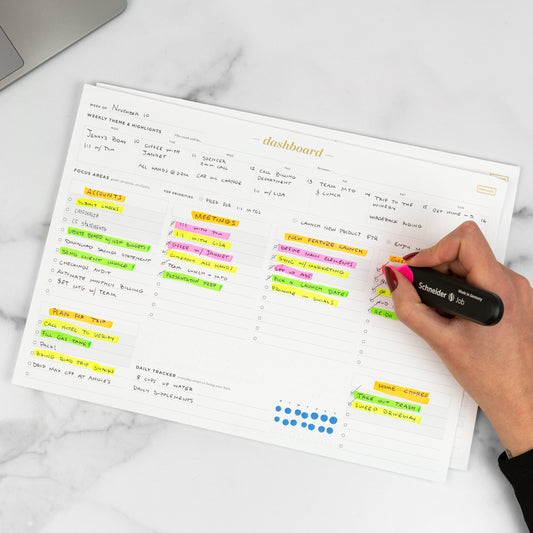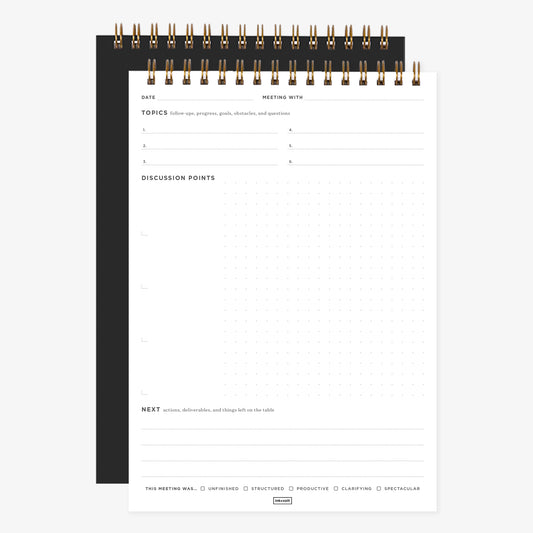Have you ever set a goal for yourself that, over time, just fizzled out?
You didn’t necessarily fail; it just didn’t happen. You didn’t make progress, your goal never got off the ground, and nothing changed. There’s no difference between the “before” and “after” picture.
It’s kinda sad, but it happens, even to goals you set with the best of intentions. But why does it happen? What makes some goals achievable, while others are so forgettable?
One of the most common reasons why goals fail to get off the ground is when they’re too nebulous. We set a goal to “lose weight” or “be happier” or “read more” — but we have no way to quantify it. Nothing to track. No way to definitively say each day, “yes, I made clear progress on that goal.”
When a goal is measurable and specific, not vague, you can actually track it and your progress. A simple example is to “brainstorm title ideas” versus “brainstorm 5 title ideas.” You either brainstorm all 5 ideas now, brainstorm some now and some later, or you don’t brainstorm any ideas at all.
Tracking this goal is straightforward and it’s obvious whether you accomplished what you set out to do or not.
For bigger and longer term goals, which can be complex and span many months and years, setting measurable goal targets becomes even more important. Setting concrete deadlines and measurable targets allows you to accurately track your progress over time.
It takes a little extra time and effort to put in this behind the scenes work, but it is worth it and can be tailored to the level of detail that matches you, your needs, and your specific goal.
Why should you track your goals?
Tracking your goals is an investment of time and energy. Yet it’s a super valuable way to ensure your goals don’t fall by the wayside and provides you with the support you need to accomplish big things.
You may be thinking that the time spent tracking your progress could be better spent actually pursuing your goal. But tracking your progress has a number of benefits, 5 of which are below:
- Concrete results are motivating. Tracking your goals provides you with vital information about how you’re doing. Why do we love checking items off a to-do list? Because it gives us a boost to see that we’ve accomplished something! And likewise, if you continually see that you’re missing targets, that gives you no ambiguity to hide behind.
- You stay honest, accountable, and on track. Tracking your progress keeps you honest with yourself; if you didn’t do something one day and you’re tracking your progress every day, you can’t avoid or just forget that you didn’t work on it. And if putting yourself and your goals first is difficult on a particular day or week and you’re debating whether to do something related to your goal or not, the process of tracking your progress will keep you accountable; you’ll feel guilty if you don’t do what you had planned.
- You stay in touch with big picture and the significance of your efforts each day. Long term goals take time, and feelings of stress or struggles along the way can overshadow the overall progress you’re making. Don’t lose sight of how far you’ve come! Tracking allows you to visualize and document your progress as time passes, helping you to stay above the everyday annoyances.
- It’s an objective way to document what happens. It’s easy to misremember or not remember something at all; and our brains aren’t always that skilled in recalling facts accurately, especially as time passes. Our feelings and emotions can take over and influence our recollection in these situations. But tracking your progress avoids inaccuracies and discrepancies when you look back.
- You can review your progress for what worked, what didn’t work, and why. When you track the progress of your goals, patterns arise and become easier to recognize. When you see a pattern that is good, repeat it or note what circumstances helped make that moment effective; if you notice a pattern that makes you less productive or interferes with your goal, nip it in the bud and take steps to avoid that situation in the future.
The inverse of each of these reasons for why you should track the progress of your goal is essentially what happens when you don’t track your progress: you lack steady motivation to pursue your goal, you get more easily off track or miss milestones, become disorganized or do things in an illogical order, and don’t see your weak spots as easily.
Big goals are like a marathon, not a sprint. They require endurance and long term, daily work that builds and depends on yesterday’s efforts. When you take the long view that process-tracking afford you, you can see that one rough day won’t derail everything and that you are in control of how much you can accomplish.
Should you track your progress on every goal?
You can track your progress on any goal, but you probably shouldn’t try to do it for every goal.
The threshold between tracking one goal and not another should be based on whether it is at a minimum specific, measurable, and time bound. Yes, it should also be attainable and relevant (remember SMART), but if it’s not specific enough to measure with an upcoming end date, what progress would you track and does it matter that you’re tracking it?
For example, if you have a goal to finish a painting, but you don’t care when it gets done and are happy working on it whenever you have free time, the implementing a progress-tracking system would only serve to distract you from a pleasant, relaxing activity that wouldn’t really benefit from a regimented system.
Instead, your time is better spent tracking those goals that are SMART and:
- big (life changing big)
- take time (diligent daily effort)
- build on or are reliant on past efforts as time goes on
For example, maybe your goal is to run a 10k race in 6 months under a certain time (takes time and builds on past efforts), or maybe it’s to pass a professional exam you’re taking in 10 months (life changing big and takes time).
But shorter term goals that also require daily effort benefit from tracking, like the 30-day challenges you take on each month. Tracking your progress tends to be simpler and less extensive for these types of goals though – they’re scaled down a bit to reflect the shorter timeline of your goal.
Strategies for figuring out what to track
With your SMART goal set and ready to go, figuring out how to track your progress is the next step. Thinking about your specific goal, consider:
- What kind of information can you track? Using the 10k race example above, you could track how you felt during your runs, what pace you ran compared to last week’s workout, or how many miles you run per week. You can be creative and brainstorm a wide range of ideas based on this question.
- Why do you want to track the information? For example, you want to identify if you’re getting stronger/faster by tracking your splits, or track how you felt during each run since numbers don’t always tell the full story and can’t be viewed in a vacuum.
- What kind of information will be most helpful to know over time? Using the example of preparing for an exam, you might want to know how many practice questions you get correct or what subject areas were weakest that improved over time. This question narrows down the list of ideas you generated in question 1, drawing your attention to those that are most useful. It takes some foresight, but just try to imagine what your future self will want to know.
- What benefit will having this information bring to you in accomplishing your goal? Will the information improve quality, efficiency, encourage or motivate you? Another variation of question 3, this will help you identify a specific reason for tracking a particular factor tied to your goal.
- How frequently do you want to track information on your goal? It could be daily or weekly, but will depend on each item. And the more complex the information is that you’re tracking, the fewer items you should track overall. You don’t want to be overwhelmed or make tracking burdensome. However, you may decide some items that are really simple can be tracked every day, and others are only tracked every week, every 10 days, or bimonthly.
- Is the information you’re going to track fact-based and objective to provide a context for other data? Whenever possible, try to track numbers and data that can be charted and tell a story you can learn from. For certain projects, it can also make sense track things like feelings (how you felt during a run, for example) to see if your confidence is improving over time too.
*Note* Always remember: tracking your progress should yield helpful results. What data will be meaningful or helpful you? Don’t just implement tracking strategies in order to say you did it. Think about what you want to learn, and work backwards.
If you track the wrong data, you might as well not do it at all.
Answering the above questions will help you do this right. Honing and fine tuning this process involves flexibility; if after a few weeks or a month you don’t think the information you’re tracking is helpful, make adjustments sooner rather than later.
Where will you track your progress?
How you organize your tracking process is the last step! Once you’ve got the items you’re going to track identified, consider where and how you’ll track each:
For the passage of time, dates, the subject matter or type of task, try crossing or checking off the days that you did ____, whether it’s every day for a 30-day challenge or a work session you have every Wednesday. You can use a simple yes or no, or add a smiley/sad face visual marker to inidicate how a session went. Your calendar or planner is an ideal format for tracking this kind of progress; for example, the Volt Planner has each day of the month at the end of the 30-day challenge page, making it easy to cross off every day you stuck with your goal.
Utilize an excel file by inputting specific information related to your goal. For example, tracking your workouts for a 10k training plan might include a column for the type of workout, miles run, total time, paces, and space to describe how you felt. From this, you can create helpful graphs using the information you’re tracking based on numbers, like your pace per mile or your mileage per week. A simple graph shows whether you’ve grown over time, increased your mileage each week, etc.
How do you like to track the progress you make on your goals and what do you do to celebrate when things go right? Share with us on Facebook!









